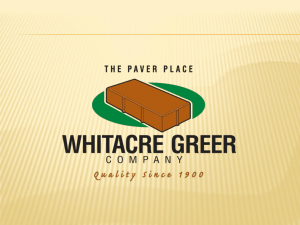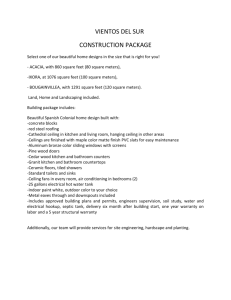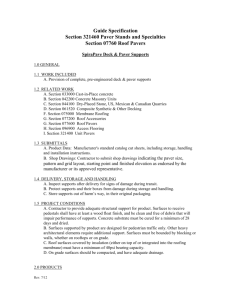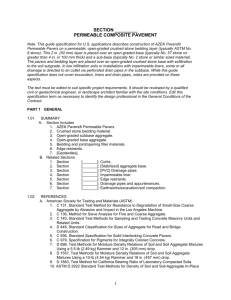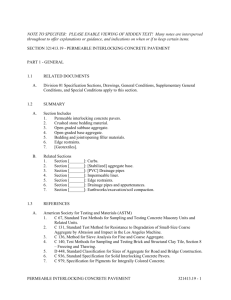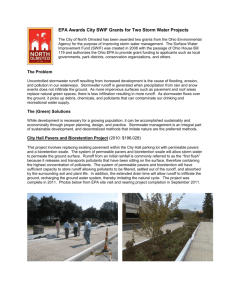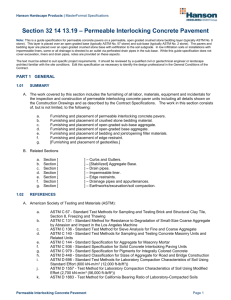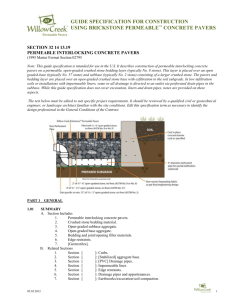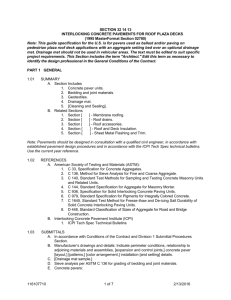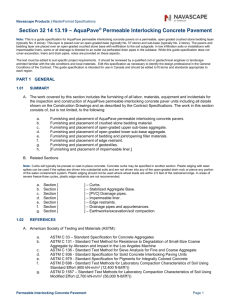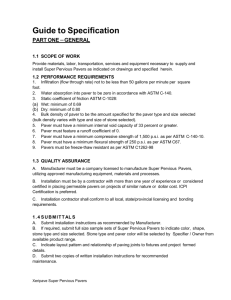Whitacre Greer Permeable Clay Brick Paver Specification
advertisement
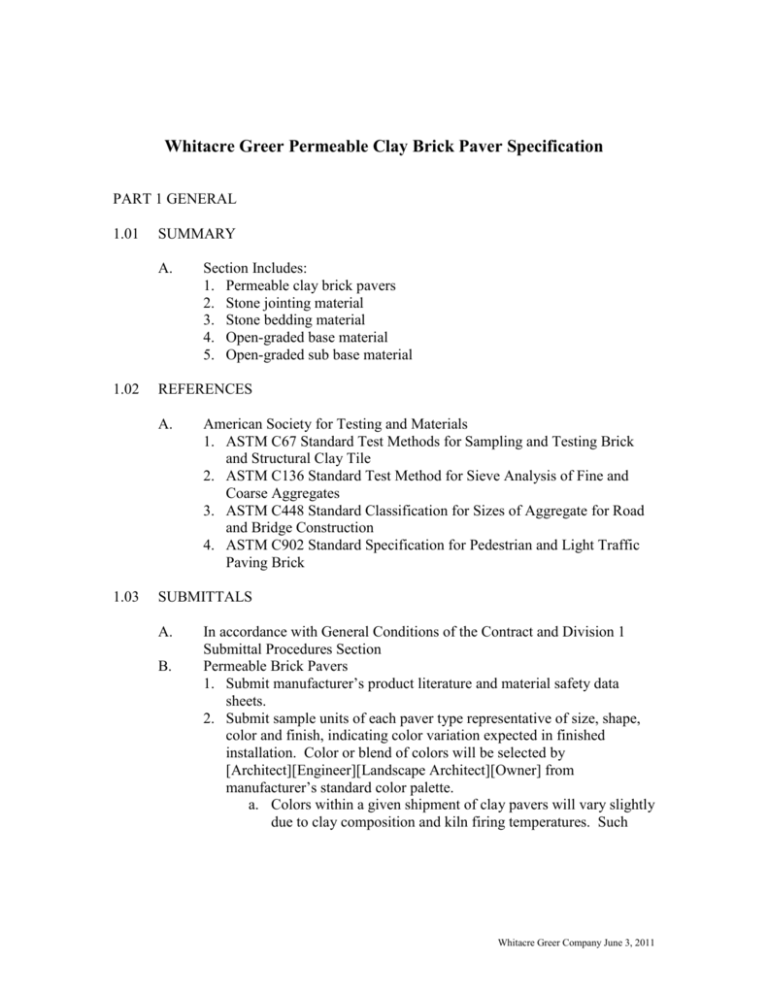
Whitacre Greer Permeable Clay Brick Paver Specification PART 1 GENERAL 1.01 SUMMARY A. 1.02 REFERENCES A. 1.03 Section Includes: 1. Permeable clay brick pavers 2. Stone jointing material 3. Stone bedding material 4. Open-graded base material 5. Open-graded sub base material American Society for Testing and Materials 1. ASTM C67 Standard Test Methods for Sampling and Testing Brick and Structural Clay Tile 2. ASTM C136 Standard Test Method for Sieve Analysis of Fine and Coarse Aggregates 3. ASTM C448 Standard Classification for Sizes of Aggregate for Road and Bridge Construction 4. ASTM C902 Standard Specification for Pedestrian and Light Traffic Paving Brick SUBMITTALS A. B. In accordance with General Conditions of the Contract and Division 1 Submittal Procedures Section Permeable Brick Pavers 1. Submit manufacturer’s product literature and material safety data sheets. 2. Submit sample units of each paver type representative of size, shape, color and finish, indicating color variation expected in finished installation. Color or blend of colors will be selected by [Architect][Engineer][Landscape Architect][Owner] from manufacturer’s standard color palette. a. Colors within a given shipment of clay pavers will vary slightly due to clay composition and kiln firing temperatures. Such Whitacre Greer Company June 3, 2011 C. D. 1.04 color variations are a natural desirable feature that gives the pavement greater character and depth. 3. Submit test results from approved independent testing laboratory indicating ASTM C902 compliance. 4. Submit manufacturer’s certification of compliance to appropriate ASTM standard. Bedding material, Open-graded Base and Sub Base material 1. Submit sieve analysis results in accordance with [ASTM C136] for jointing, bedding, base and sub-base material. 2. Provide supplier name, source and types of material used for jointing, bedding, base and sub base. Paving Installer 1. Job references from projects similar in size and design to this project. Provide [Owner][Client][General Contractor] names, postal address, phone, fax and email address. QUALITY ASSURANCE A. B. C. Paving Installer Qualifications 1. Three years experience with at least [25,000] feet of segmental permeable pavers installed. 2. Successful completion of [five] permeable paver installations similar in design, material and extent indicated on this project. Installer shall have experience setting clay/brick pavers. 3. Successful completion of a [School for Advanced Segmental Paving][Interlocking Concrete Paver Institute] permeable paving installation certificate course. Regulatory Requirements 1. Installer shall be able to provide bonds required for the work. Mock-Ups 1. Install a [10 ft by 10 ft][5 ft by 5 ft] area of pavers on a prepared substrate including detail to illustrate component application including pattern and edge details. 2. When required, provide a separate mock-up for each paver type and bonding pattern. 3. Use mock-up to determine pre-compaction setting bed level, joint sizes, lines, laying patterns and product color. 4. Do not start work until mock-up has been approved by [Landscape Architect][Architect][Engineer][Owner]. Whitacre Greer Company June 3, 2011 D. 1.05 DELIVERY, STORAGE AND HANDLING A. B. C. 1.06 Procurement 1. Allow adequate time for the production and delivery of specified paver. Consult local distributor for lead-time and delivery options. Delivery 1. Deliver materials in Whitacre Greer’s original, unopened, undamaged packaging with identification labels intact. Unload pavers with proper equipment so no damage occurs to pavers. Storage 1. Store materials so they are protected from contamination by foreign substances and excessive moisture. 2. Store pavers to prevent damage and staining. PROJECT CONDITIONS A. 1.07 5. Approved mock-up is the standard by which appearance, workmanship, substrate preparation and material application will be judged. 6. Approved field sample may be retained as part of finished work. Remove mock-up and dispose of materials when directed by [Landscape Architect][Architect][Engineer][Owner]. Pre-Installation Meetings 1. Conduct pre-installation meeting [one week] prior to commencing work of this section to verify project requirements, substrate condition and coordination with other trades, installation instructions and warranty requirements. Environmental Requirements 1. Do not install in rain or snow. 2. Do not install frozen bedding material. MAINTENANCE A. Extra Materials 1. Furnish [specify quantity] additional pavers to owner for future maintenance and repair. 2. Pavers shall be from the same production run as the installed materials. PART 2 PRODUCTS Whitacre Greer Company June 3, 2011 2.01 DESIGN NOTE A. B. C. 2.02 PERMEABLE CLAY BRICK PAVERS A. 2.03 Consult an engineer for hydrology and load-bearing design considerations. Use pavement slopes of not more than 5% for optimum results. Consider under drains for overflow or water harvesting. 1. Consult an engineer for placement of drains. Permeable Paver Type 1. [4x8x2¼ Permeable][4x8x2¾ Permeable][2¼x9x3 Boardwalk Permeable] a. Manufactured by The Whitacre Greer Company, 1400 South Mahoning Ave, Alliance, OH 44601 Telephone: (800) 9472837 Fax: (330) 823-5502 Email: info@wgpaver.com b. Distributed by [enter local distributor and appropriate contact]. 2. Material standard in accordance with ASTM C902. 3. Classification: Specify weathering, traffic and application classifications. a. Specify Class: SX b. Specify Type: I c. Specify Application: PS AGGREGATE MATERIALS A. Bedding Course and Joint Filler 1. [#9][#89] Crushed stone conforming to ASTM D448 2. Washed with less than 1% passing through the No. 200 sieve. ASTM No. 9 Sieve Size Percent Passing 9.5 mm (3/8 in.) 100 4.75 mm (No. 4) 85 to 100 2.36 mm (No. 8) 10 to 40 1.18 mm (No. 16) 0 to 10 0 to 5 300 m (No. 50) B. ASTM No. 89 Seive Size Percent Passing 12.5 mm (1/2 in.) 100 9.5 mm (3/8 in.) 90 to 100 4.75 mm (No. 4) 20 to 55 2.36 mm (No. 8) 5 to 30 1.18 mm (No. 16) 0 to 10 0 to 5 300 m (No. 50) Base Course 1. #57 Crushed stone conforming to ASTM D448 2. Washed with less than 1% passing through the No. 200 sieve. Whitacre Greer Company June 3, 2011 ASTM No. 57 Sieve Size Percent Passing 37.5 mm (1-1/2 in.) 100 25.0 mm (1 in.) 95 to 100 19.0 mm (3/4 in.) 12.5 mm (1/2 in.) 25 to 60 9.5 mm (3/8 in.) 4.75 mm (No. 4) 0 to 10 2.36 mm (No. 8) 0 to 5 C. 2.04 Sub Base Course 1. #2 Crushed stone conforming to ASTM D448 2. Washed with less than 1% passing through the No. 200 sieve. ASTM No. 2 Sieve Size Percent Passing 75 mm (3 in.) 100 63 mm (2-1/2 in.) 90 to 100 50 mm (2 in.) 35 to 70 37.5 mm (1-1/2 in.) 0 to 15 25.0 mm (1 in.) 19.0 mm (3/4 in.) 0 to 5 ACCESSORIES A. B. Edge Restraints 1. All installations must be properly restrained with an edge restraint suitable for the expected pavement load; cast in place concrete, set in place concrete or granite curbs, spiked in place plastic, steel or aluminum. a. Spiked in place edge restraints require modified installation method. 2. Follow the recommendations of the restraint manufacturer if applicable. Geotextiles (Optional – Follow manufacturer’s recommendations) 1. Material type and description: [Specify material type and description]. 2. Material standard: [Specify material standard]. 3. Manufacturer: [Specify manufacturer]. Whitacre Greer Company June 3, 2011 PART 3 EXECUTION 3.01 ACCEPTABLE INSTALLER A. 3.02 EXAMINATION A. 3.03 [Specify acceptable paver installation contractor.] Verify Site Conditions 1. General contractor shall inspect and certify in writing to installer that site conditions meet the following prior to installation of permeable clay pavers. a. Remove organic, unstable or unconsolidated material from the site. b. Verify conformance of sub grade preparation and elevations to specified requirements. If CBR (California Bearing Ratio) is less than 5%, typically with clay soils, compaction of sub grade and geotextile may be required. c. Verify sub base and base conformance to specified requirements. Do not use setting bed material to correct deficiencies in base course surface. d. Verify written density test results for soil sub grade and sub base course. e. Verify type, location and elevations of edge restraints, utility structures and drainage inlets. f. Verify that the [sub base][base] course is ready to support bedding material, permeable pavers and imposed loads. 2. Do not proceed with bedding course or paver installation until satisfactory [sub grade soil][sub base][base] are verified by contractor. 3. Verify that the area is free from standing water and certified by general contractor as meeting material, installation and grade specifications. 4. Field measurements a. Determine actual paver dimensions (including tolerances) and coordinate with dimensions for pavement areas indicated on contract drawings prior to any pavement installation. Adjust pavement area dimensions to eliminate unnecessary paver cutting. PREPARATION A. Edge Restraint Preparation Whitacre Greer Company June 3, 2011 B. 3.04 1. Install as per drawings [at indicated elevations]. Aggregate Material 1. Stockpile joint filler material, base and sub base material such that they are free from standing water, uniformly graded, free of organic mater or sediment, debris, and ready for placement. INSTALLATION A. B. C. D. General 1. Keep area where pavement is to be constructed free from sediment during entire job. Contaminated sub base, base or bedding material shall be removed and replaced with clean material. 2. Do not damage drainpipes, overflow pipes, observation wells or any inlets and other drainage elements during installation. Report damage to project engineer. Geotextiles (if applicable) 1. May be required if CBR is less than 5%. 2. Place on bottom and sides of soil sub grade. Secure in place to prevent wrinkling from vehicle tires and tracks. 3. Overlap a minimum of [12 inches][24 inches] in the direction of drainage. Sub Base Aggregate 1. Spread and compact moistened No. 2 sub base in 4 to 6 inch lifts. a. Typical sub base thickness is 6 to 18 inches. b. Reduce the depth of each lift if plate tamper is used for compaction. 2. Make at least two passes in the vibratory mode then at least two in the static mode for each lift. A minimum 10-ton vibratory roller should be used. Compact until there is no visible movement of the No. 2 stone. a. A plate tamper with 13,500 Lbf may be used for smaller installations. 3. Surface tolerance of No. 2 sub base shale be +/-3/4 inches over a 10foot straightedge. Base Aggregate 1. Spread and compact moistened No. 57 base in one 4-inch lift. a. Spread in multiple reduced-depth lifts if plate tamper is used for compaction. 2. Make at least two passes in the vibratory mode then at least two in the static mode for each list. A minimum 10-ton vibratory roller should be used. Compact until there is no visible movement of the No. 57 stone. Whitacre Greer Company June 3, 2011 E. F. G. 3.05 a. A plate tamper with 13,500 Lbf may be used for smaller installations. 3. Surface tolerance of No. 57 base shale be +/-1/2 inch over a 10-foot straightedge. Bedding Course Aggregate 1. Spread and screed moistened No. [9][89] stone bedding material. 2. Fill voids left by removing screed rails with No. [9][89] stone. 3. Surface tolerance of No. [9][89] bedding course shall be +/-1/8 inch over a 10-foot straightedge. 4. Do not compact bedding course. 5. Keep pedestrian and vehicular traffic off screeded bedding course until paver installation begins. Permeable Clay Pavers 1. Install paving units in pattern(s) indicated on drawings. Maintain straight pattern lines using string and/or chalk lines. a. Maximum bond line variation shall be +/-3/8 inch over a 50foot string line. 2. Fill gaps at the edges of the paved area with cut unites. Cut pavers subject to vehicular traffic shall be no smaller than 1/3 of a whole unit. Joint Material 1. Fill openings and joints between paver units with No. [9][89] stone. 2. Sweep excess joint material from paved area. 3. Compact pavers into bedding course using low-amplitude plate compactor capable of at least 5,000 lbs centrifugal compaction force. Make at least two passes with the plate compactor. a. Protect paver surface with mat attached to tamper or other approved method. 4. Do not compact within 6 feet of an unrestrained edge. 5. Apply additional No. [9][89] stone to joints as required to fill them completely. 6. Pavers within 6 feet of the laying face shall be left fully compacted at the completion of each day. 7. Surface tolerance of finished pavement shall be not more than +/-3/8 inch over a 10-foot straight edge. 8. Surface elevation of finished pavement shall be 1/8 to 1/4 inches above adjacent drainage inlets. FIELD QUALITY CONTROL A. Sweep surface clean and verify conformance with drawings. Whitacre Greer Company June 3, 2011 B. C. D. 3.06 Verify that adjacent pavers have not more than 1/8 inch difference in height. Verify final elevation of pavement to adjacent drainage inlets. Verify straightness of bond lines. PROTECTION A. After work in this section is complete, General Contractor shall protect work from damage due to subsequent construction activity on site. Whitacre Greer Company June 3, 2011

